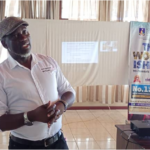Kayelekera Uranium Mine and Economic Development in Malawi
Published on February 7, 2013 at 12:37 PM by FACE OF MALAWI
Summary
- Malawi’s role as a labour supplying country to South African mines was halted by the HIV scare in 1987 and as a result, the Government of Malawi has ventured into its own mineral exploration, including the Kayelekera uranium project.
- Thus far, revenue from Malawian mines has not been optimized for the public good due to the presence of companies operating without properly negotiated agreements.
- Malawi should consider impose stricter environmental and financial conditions on mining corporations to realize this potential source of economic development.
Background
Compared to others in Africa, Malawi is not known as a country endowed with extensive mineral wealth. While Malawian labourers were sent to South African mines during colonization, for instance, its own extractive development stagnated until the 1990s. While many Malawians therefore hold experience as mineworkers, typically it was not gained in their own country (Mtika, 2007).
The post-independence period in the 1960s did not lead to significant changes with the country continuing to encourage the recruitment of Malawian miners as a portion of their wages was repatriated by the South African government, providing a valuable source of income against which to leverage taxes (Chirwa, 1999).
This relationships persisted until Malawian mineworkers were deported from South Africa in the 1980s due to fears that many were living with HIV (Chirwa, 1997). The retrenchment negatively impacted migrant-sending communities across Malawi, exacerbating high levels of unemployment.
To address lack of employment and the resulting economic deprivation, in the 1990s Malawi began to venture into mineral exploration (Chirwa, 1999:13). But while recent indications show the country is endowed with significant mineral wealth (Government of Malawi, 2011: 38-46), it has not always developed these resources effectively. This paper focuses on the Kayelekera mining project to highlight a missed development opportunity for Malawi.
The Kayelekera Uranium Mine Site
In the early 1990s the Central Electricity Generating Board of Great Britain (CEGB) discovered high grade sandstone uranium deposits at the Kayelekera site in Malawi. Paladin Africa Limited (Paladin) records that CEGB spent $9 million (all figures USD) working on the project over a subsequent eight year period, culminating in a feasibility study that assessed the viability of an open pit mining operation. After finding that the project was uneconomic based on the mining method and low uranium prices prevailing at that time, the project was briefly abandoned (Paladin, 2012).
In 2000, however, Paladin saw fit to acquire a 90 percent share of the stalled Kayelekera project, and in July 2005, purchased the remaining 10 percent stake. Under the subsequent Terms of Development Agreement with the Government of Malawi, the state also holds 15 percent equity in the project (Government of Malawi, 2011: 42).
Legal Framework for Mining Activities in Malawi
All mineral activities in Malawi are covered by the Mines and Minerals Act of 1981, the Mineral Rights Regulations of 1981 and the Petroleum Exploration and Production Act of 1983. As the Mines Act was passed during Hastings Banda’s one party government — and has yet to be amended — all minerals in the country are still vested in the president on behalf of Malawians.
After Malawi’s transition toward democracy in 1994 and the adoption of a new constitution in 1995, a review of environmental policies was performed. Several provisions were inserted in the Mines and Minerals Act, including a stipulation that an environmental impact assessment (EIA) had to be submitted to the Department of Environmental Affairs for review. However, no substantive changes were made to reflect emerging international best practices (Hajat, 2010: 5-6). The process for granting mining licenses, for example, still vests power in ministerial discretion and does not require consultations with other stakeholders such as Parliament or civil society.
At present, Malawi issues three types of mining licences: mineral permits, exclusive prospecting licences and mining licences. The normal processing time for granting mining licences is two to 12 months (Government of Malawi, 2011). The government, however, has sometimes relaxed its policies: site occupation and population relocation at Kayelekera uranium site, for example, occurred before Paladin submitted its EIA (Hajat, 2010: 8),and construction works started before the company possessed a mining licence (CHRR, 2007). In other words, Paladin considered granting of the mining licence a foregone conclusion, which it was; the company submitted its draft EIA in October 2006 and was granted a mining licence in February 2007 (Hajat, 2010: 1).
Concerns over Uranium Mining at Kayelekera
The Government of Malawi’s decision to grant a mining licence to Paladin based on the company’s draft EIA was criticised by civil society groups in the country. Concerns bordered on three issues. The first was secrecy (CHRR, 2007): Paladin refused to provide information to local communities prior the performance of a substantive EIA. This is typically done to ensure community input. Even when information about the EIA was made available, accessibility was problematic — the document was published in English only, excluding many from the process.
The EIA process was also not independently conducted. The company Knight Piesold (KP) was subcontracted by Paladin to investigate various aspects of the EIA, but the objectivity of the outcomes was questioned on grounds that a business-client relationship existed between KP and Paladin. Civil society groups then carried out their own assessment through environmental engineering consultants Mudd and Smith.
Mudd and Smith revealed that the EIA excluded detailed background information and source materials against which the public could test KP’s underlying assumptions and conclusions (Mudd and Smith, 2007: 9). The EIA emphasized potential economic benefits of the project, for example, while downplaying negative environmental impacts. It also lacked environmental and radiological baseline data, figures and maps to present the project ,and long-term tailings management/site rehabilitation plans (Mudd and Smith, 2006: 1-21).
The second cause for concern was a threat to air and water resources surrounding the Kayelekera site, which is located on a tributary river that flows into Lake Malawi (Mudd and Smith, 2007: 11-14). Lake Malawi is the third largest freshwater lake in Africa, and its fish are a vital source of food and income for millions of Malawians, Tanzanians and Mozambicans. The EIA did not mention if water sources would be utilised or affected, while transporting a sensitive mineral such as uranium by land was also a cause for concern (Mudd and Smith, 2007: 3). The EIA did not make any mention of the possible impacts that processing and transporting uranium could have. It is still unclear whether there has been any substantial involvement by global monitoring bodies such as the International Atomic Energy Agency (IAEA).
The final concern from civil society was the divide and rule tactics that Paladin used to manipulate the local community (Hajat, 2010).The company was allegedly making direct payments to traditional leaders, undermining local decision-making processes, and paying improper monthly allowances to government engineers in the Department of Mines and Natural Resources. Additionally, relocated families were only given only $95.00 (Hajat, 2010: 8) and local communities surrounding the site could be vulnerability to relationships of transactional sex (and increased HIV infection rates), as has happened in other mine areas in southern Africa (Crush, 2010).
The Way Forward
If Malawi has mineral deposits of global significance, there is a need for the national government to develop a policy framework to realize this potential source of wealth.
Resources, such as uranium at Kayelekera, have the potential to bring positive economic development to Malawians, and help address problems of unemployment and external migration. Revenue to the government will remain minimal, however, given its eagerness to accommodate mining companies. A new wave of economic exploitation of mineral resources through foreign investment, private sector development and trade liberalization could result in a lost opportunity for Malawi. The government is in a position to demand better deals from, and to impose much stricter conditions on, mining corporations that operate within its borders.
Works Cited
Centre for Human Rights and Rehabilitation (2007). Press Statement on Concerns Over uranium Mining in Malawi. November. Washington DC: Nuclear Monitor. Available at: http://www.nirs.org/mononline/nm638.pdf
Chirwa, Wiseman C (1997). “Migrant Labour, Sexual Networking and Multi-partnered Sex in Malawi.” Health Transition Review, Vol. 7, No. 3, 5-15.
—— (1998). “Aliens and AIDS in southern Africa: The Malawi-South
Africa Debate.” African Affairs, Vol. 97, 53-79.
—— (1999). “Jailing the Voiceless: Ex-migrant Workers and Popular
Struggles in Malawi.” Nordic Journal of African Studies, Vol. 8, No. 1, 1-20.
Crush, Jonathan (2010). “Migration-Induced HIV and AIDS in Rural Mozambique and Swaziland.” Pretoria, South Africa: Southern Africa Migration Project and International Organisation for Migration.
Government of Malawi (2011). Malawi Annual Economic Report. December.
Lilongwe: Ministry of Development Planning and Cooperation. Available at: http://psip.malawi.gov.mw/reports/docs/Economic_Report_2011.pdf
Hajat, Rafik (2010). “A Situational Analysis of Mines and Minerals in Malawi.”
Blantyre, Malawi: Institute for Policy Interaction. Available at: http://www.ipimalawi.org/reports/reports/Sit%20analysis%20of%20Minerals%…
Mtika, Mike M (2007). “Political Economy, Labour Migration and the AIDS Epidemic in Rural Malawi.” Social Science and Medicine, Vol. 64, 2454-2463.
Mudd, Gavin M and Howard Smith (2007). “Comments on the Proposed Kayelekera uranium Project Environmental Impact Assessment Report.” Clayton, Australia: Monash University. Available at: http://users.monash.edu.au/~gmudd/files/Comments-Kayelekera-EIS-Draft-v3…
Paladin Africa Limited (2012). “Project Update for Kayelekera Mine.” February.
Monash, Australia. Available at: http://www.paladinenergy.com.au/default.aspx?MenuID=14
About the Author
Wilfred Masebo is a Ph.D. student in development studies at the University of KwaZulu-Natal in Durban, where he is studying labour migration networks and HIV in Malawi. Wilfred holds an M.A. in labour, policies and globalization from the Berlin School of Economics and Law, and previously served as head of programs and research for the Teachers Union of Malawi. Most recently, Wilfred worked as a research and training coordinator at the Centre for Human Rights and Rehabilitation in Malawi.
- Malawi’s role as a labour supplying country to South African mines was halted by the HIV scare in 1987 and as a result, the Government of Malawi has ventured into its own mineral exploration, including the Kayelekera uranium project.
- Thus far, revenue from Malawian mines has not been optimized for the public good due to the presence of companies operating without properly negotiated agreements.
- Malawi should consider impose stricter environmental and financial conditions on mining corporations to realize this potential source of economic development.


